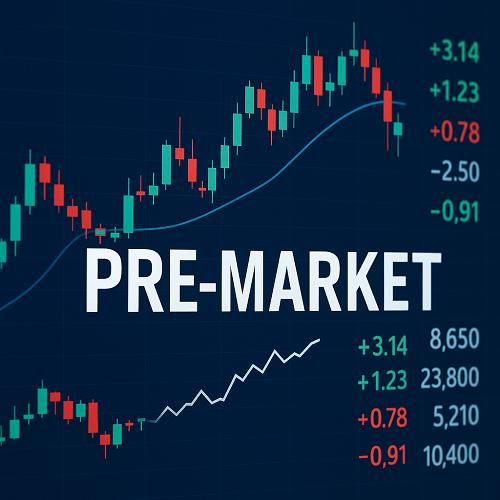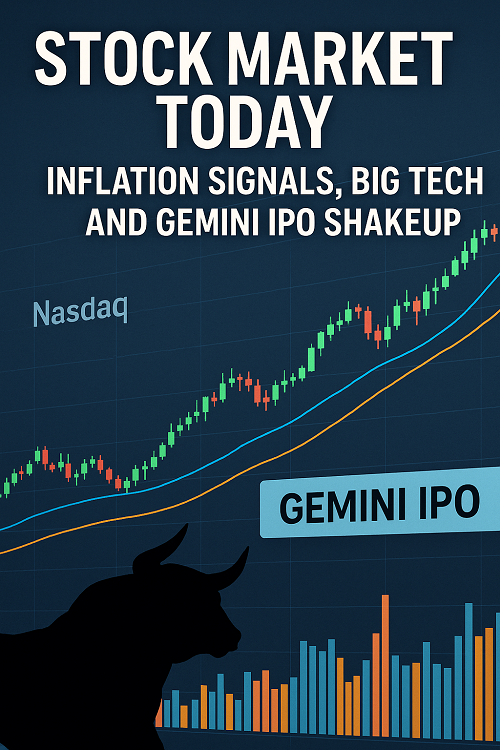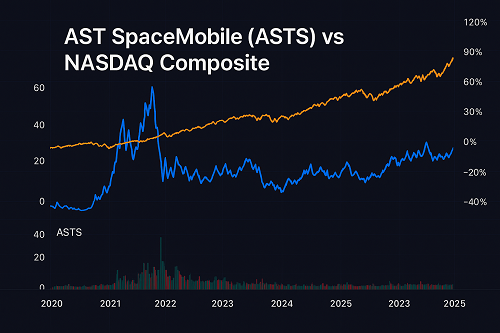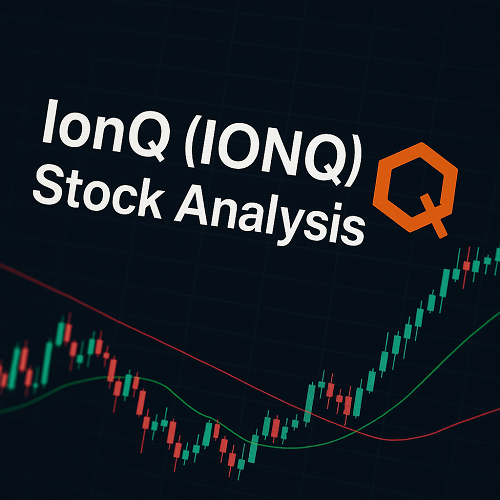Why Pre-Market Activity Matters
Many traders think the U.S. stock market only “starts” at 9:30 a.m. ET, but in reality, a meaningful volume of trading and price discovery already occurs before then. The premarket session offers an early window into how overnight news, economic releases, and global markets will influence U.S. equities. The Nasdaq Pre-Market / Nasdaq-100 Pre-Market Indicator (QMI) is one of the key gauges that market participants watch to infer early directional bias.
By observing pre-market trends, traders can position themselves ahead of the opening bell, gauge strength or weakness, and understand the likely open levels for key stocks or indices. But pre-market comes with unique challenges: lower liquidity, wider spreads, and higher volatility.
This guide is your end-to-end resource to understand, interpret, and trade the Nasdaq pre-market (and U.S. equity pre-market more broadly) like a professional.
What Is Pre-Market Trading?
Definition & Timeframes
- Pre-Market Trading refers to stock trading activity occurring before the official market open (9:30 a.m. ET).
- The full extended hours “pre-market window” typically spans 4:00 a.m. to 9:30 a.m. ET.
- Many brokers restrict retail access to narrower slices (often beginning 7:00 a.m. or 8:00 a.m. ET).
How It Works (ECNs, ATS, Order Types)
- Pre-market trading is facilitated by Electronic Communication Networks (ECNs) or Alternative Trading Systems (ATSs) — not via the traditional exchange floor.
- Trades must typically be limit orders (market orders are usually disallowed) to protect against extreme price slippage.
- Because participation is voluntary, liquidity is far lower, and bid-ask spreads are often much wider.
Nasdaq-100 Pre-Market Indicator (QMI)
- The Nasdaq-100 Pre-Market Indicator (QMI) is computed similarly to the Nasdaq-100 index, but using last sale prices during pre-market (8:15 a.m. to 9:30 a.m. ET) for component stocks. If a security doesn’t trade, its prior day closing value is used.
- The QMI serves as a sentiment barometer just before the market open, offering cues about where Nasdaq 100 may open.
Advantages & Disadvantages of Pre-Market Trading
Key Benefits
- Early News Reaction: You can act on earnings, FDA approvals, mergers, or macro news before the crowd.
- Price Discovery: Initial gaps, support/resistance levels, or trend biases are revealed ahead of regular hours.
- First-Mover Advantage: Traders who read pre-market cues may get favorable entries before full liquidity arrives.
- Flexibility: For global or non-U.S. traders, pre-market provides a chance to respond outside standard domestic hours.
Major Risks & Constraints
- Low Liquidity: Fewer participants lead to stalled orders, wide spreads, and partial fills.
- Volatility & Gaps: Price swings can be exaggerated; reversals are common when regular hours open.
- Execution Risk: Limit orders may never fill; market orders (if allowed) can be disastrous.
- Information Mismatch: Pre-market moves may not hold once the broader market catches up.
- Broker Limitations: Some brokers restrict which stocks or how much volume you can trade in pre-market.
Because of these, many seasoned traders advise: “Pre-market is to be observed, not played”—unless you have strong justification.
Pre-Market vs Regular Session: Key Differences
| Feature | Pre-Market | Regular Session |
|---|---|---|
| Liquidity | Low | High |
| Spread | Wide | Narrow |
| Volume | Low | High |
| Order Types | Mostly limit | Limit + market + others |
| Price execution risk | High | Lower |
| Reversal likelihood | Higher | Lower (though still possible) |
| Reaction speed | Fast & abrupt on news | More orderly price movement |
Because of these structural divergences, strategies must adapt. What works in the regular session may fail dramatically in pre-market.
Participants & Market Structure in Pre-Market
- Institutions & Hedge Funds: Often dominate pre-market volume.
- Retail Traders: A smaller slice, usually focused on news-driven trades or gap setups.
- Market Makers / Liquidity Providers: Less active, leading to thinner depth.
- Algorithmic / High-Frequency Trading: Some are active, but largely muted relative to regular hours.
Given this dynamic, directional moves in the pre-market often represent institutional conviction rather than random retail frenzy.
How to Access Pre-Market Trading (Broker Requirements)
Broker Eligibility & Setup
- You must have a broker that supports extended hours / pre-market trading.
- You may need to opt in / agree to disclaimers about risks.
- Access is often limited to certain account types (e.g. “Pro” or active trader accounts).
Order Types & Rules
- As noted, only limit orders are typically allowed; stop, market, and trailing stops often won’t work.
- Orders generally do not carry over into the regular session (unless specified).
- Check minimum quantity and stock eligibility—some low-volume or micro-cap stocks are disallowed.
Notable Broker Examples
Brokers such as Interactive Brokers, Webull, TD Ameritrade / Schwab, E*TRADE, and others support varying degrees of pre-market trading. Always confirm your broker’s current policies, since times and rules may shift.
Interpreting Nasdaq’s Pre-Market Data
Pre-Market Quotes & Trades
- Nasdaq offers “Latest Pre-Market Trades” pages for stocks, showing the last trades, sizes, and pricing ranges.
- For individual Nasdaq stocks, their pre-market pages display volume, bid/ask, and change vs close.
Volume, Spread, and Liquidity Metrics
- Because volume is compressed, look for relative spikes (e.g. >2× normal pre-market baseline).
- Watch for spread expansions—if the bid-ask widens drastically, risk is heightened.
- Observe whether the size / depth at the bid or ask is meaningful. Thin size indicates fragility.
Sentiment & Price Discovery
- Strong pre-market moves usually signal sentiment—gaps up/down, sustained buying or selling.
- However, many gap moves in pre-market fade or reverse as the regular session brings more participants.
- The QMI indicator gives aggregate directional sense for Nasdaq 100 just before open.
Interpreting pre-market data is more art than science — it’s about context, conviction, and readiness to react.
Pre-Market Strategies & Tactics
Here are proven strategies adaptable to the pre-market environment:
1. News / Earnings Reaction Plays
- Monitor for company-specific news (earnings beats, FDA results, guidance updates) announced before market open.
- If a stock gaps up with volume, enter with a limit order near the pre-market trade price, with tight risk control.
- Beware blow-off moves—if the move is too aggressive, it may reverse hard once the crowd enters.
2. Gap Plays & Breakouts
- Identify stocks that gap up or gap down relative to previous close, and look for early breakout continuation.
- Use previous day resistance / support as reference zones.
- Target the pre-market high/low as breakout threshold.
3. Fade / Reversal Tactics
- In cases where the gap is extreme, some traders try to fade: i.e. short after a strong pre-market advance if signs of exhaustion emerge.
- This is riskier due to low liquidity — only advisable with strong cues (weak volume on the advance, divergence, etc.).
4. Using Futures as a Guide
- Monitor S&P 500 futures, Nasdaq futures, and index futures overnight — these often steer pre-market direction.
- If futures are sharply up/down, many correlated stocks may echo the same. Use that signal as a directional bias.
5. Scaling In, Limit Orders, and Risk Controls
- Use partial entries instead of going full size at once.
- Place limit orders, not market orders.
- Define stop-loss zones (though many brokers don’t allow stop orders in pre-market — you may need to monitor manually).
- Exit early if liquidity dries up or spreads blow out.
9. Pre-Market Trading Checklist
Here’s a daily checklist you can use to prepare:
| Step | Action | Why It Matters |
|---|---|---|
| 1 | Review overnight / premarket news & earnings | Identify catalysts that might drive movement |
| 2 | Check futures (S&P, Nasdaq) | Gauge macro directional bias |
| 3 | Scan pre-market movers (top gainers/losers) | Spot potential trade candidates |
| 4 | Compare pre-market volume vs baseline | Validate strength of moves |
| 5 | Mark key levels from prior session (support/resistance) | Use them for entries/exits |
| 6 | Pre-place limit orders with clear stops/targets | Prevent emotional mistakes |
| 7 | Monitor spreads & liquidity | Avoid trades during spread blowouts |
| 8 | Scale in and consider partial exits | Protect in volatile environment |
| 9 | Be ready to abort if trade conditions deteriorate | Always preserve capital |
This structured approach ensures you trade with a plan, not impulsively.
Real-World Examples & Case Studies
Let’s look at hypothetical scenarios to illustrate how pre-market strategies play out (you can adapt with real tickers when live).
Example 1: Earnings Beat & Gap-Up Entry
- Company A reports strong earnings at 7:30 a.m. ET, revises guidance upward.
- Pre-market, stock jumps +8% on sudden volume.
- You enter with a limit order at +5% relative to prior close, size small.
- As liquidity builds, price continues upward — you take partial profits near +9%.
- At open, price holds, confirming momentum.
Example 2: Gap Fade / Reversal
- Company B announces weak guidance pre-market; stock drops sharply -10%.
- After an initial oversell spike, you sense a rebound attempt.
- You short a partial position on slight bounce (fade strategy), with tight stop just above pre-market high.
- If the bounce fades under volume contraction, you cover for a small profit.
Example 3: Index Futures as a Leading Indicator
- Overnight, Nasdaq futures rise +1.2%.
- Many tech stocks show upward momentum in pre-market.
- You target strong tech names that gap up and break above pre-market resistance.
- The strategy aligns with macro trend and widens odds in your favor.
When using real ticker data, always backtest and paper trade until comfortable.
Best Practices, Mistakes to Avoid & Tips
Best Practices
- Trade smaller size due to high volatility.
- Always use limit orders.
- Focus on names with pre-market volume (liquidity).
- Have clearly defined entry, exit, and stop plans.
- Monitor spreads dynamically — if spreads blow out, stand aside.
- Be disciplined — if trade plan fails, cut losses quickly.
Common Mistakes
- Placing market orders (leading to extreme slippage)
- Overtrading — jumping on weak signals
- Ignoring spread and depth (e.g. trading thinly traded penny stocks)
- Failing to respect reversal potential at open
- Not considering index/futures context (losing macro alignment)
Pro Tips
- Use Level II / depth of market when offered in pre-market (if available).
- Track pre-market movers via scanners / screener tools (e.g. MarketWatch, Nasdaq pre-market screener).
- Pay attention to global markets (Asia, Europe) — their overnight trends often spill into U.S. pre-market.
- Use checklists to avoid emotional errors.
- Start with liquid large-cap names before venturing into small caps.
Future Trends: 24-Hour Trading, Extended Hours, and What to Watch
- Nasdaq is actively planning 24-hour trading (five-day per week), potentially rolling out in the second half of 2026.
- If implemented, this would diminish the “pre-market vs regular” divide and shift overnight and global session dynamics.
- Watch regulatory filings, liquidity distribution in new hours, and broker adaptation costs.
- For now, extended hours remain segmented (pre-market, regular, after-hours), but the landscape is evolving.
Frequently Asked Questions (FAQ)
Q. Can I trade options in pre-market?
A. Generally, no — options trading is usually limited to regular hours.
Q. Will pre-market prices always carry into regular trading?
A. No — pre-market moves often reverse or fade once liquidity floods in.
Q. How reliable is the Nasdaq Pre-Market Indicator (QMI)?
A. It’s a helpful directional guide but not foolproof; treat it as one of several tools.
Q. Is pre-market trading more dangerous for retail investors?
A. Yes, due to wide spreads, low liquidity, and higher volatility — risk management is crucial.
Q. Should beginners try pre-market trading?
A. It’s better to master regular session trading first. If you proceed, start small, paper trade, and focus on high-volume names.
Conclusion
Pre-market trading is a powerful tool in a trader’s arsenal — one that can offer early price discovery, reaction to overnight developments, and first-mover advantage. Yet it demands respect for its unique challenges: low liquidity, volatile swings, and execution risk.
By understanding the mechanics (ECNs, limit orders, Nasdaq’s QMI), carefully interpreting pre-market signals, and applying disciplined strategies (news plays, gap setups, fade tactics), informed traders can navigate this environment profitably.
The path to mastery involves consistent routine: news scanning, futures alignment, order preparation, and strict risk discipline. And as market structure evolves — with potential 24-hour trading on the horizon — understanding pre-market is no longer optional but essential to staying ahead.





 XAUT-USD
XAUT-USD  AMD
AMD  MARA
MARA  SHOP
SHOP  BULL
BULL  CL=F
CL=F